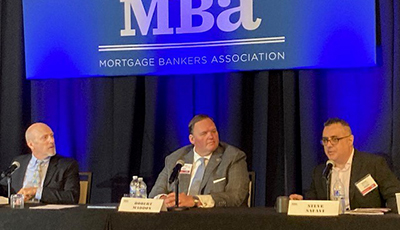
#MBARMQA22: Strategies for Detecting Fraud

((l-r) Robert Maddox, CMB, AMP, and Steve Safavi.)
NASHVILLE, TENN.—The current mortgage fraud environment is evolving, with new risks emerging in a post-pandemic environment, analysts said here at the MBA Risk Management QA and Fraud Prevention Forum.
“You have a housing affordability issue, and that’s creating problems for potential homeowners,” said Steve Safavi, Vice President of Mortgage Fraud and Anti-Money Laundering Officer with Mr. Cooper, Frisco, Texas. “Instead of buying, many are renting, and this is creating opportunities for investors and occupancy fraud.”
Safavi outlined a seven-step process for lenders to identify and resolve cases of mortgage fraud:
–Training: know the ‘red flags;’ for example, the owner has multiple properties or an appraisal shows the property as “owner-occupied.”
–Automation: Establish automated rules based on red flags
–Filtering data: Rule out false positives by adding layers to automated rules
–Testing: Continuously test and update rules
–Partnership: “Vendors and data scientists should be flexible when new rules need to be updated,” Safavi said. “Partnership and synergy are critical.”
–Re-Test Rules: Compare actual case studies to the risk model
–Escalation: “Create an escalation process when patterns are identified, specifically when suspecting widespread fraud,” Safavi said.
“It’s important to have good processes in place,” said Robert Maddox, CMB, AMP, Partner with Bradley LLP, Birmingham, Ala. “As an outsider from a law firm, I’m going to ask you for your processes; and I am going to see if you follow them. And if you haven’t, I’m going to know it.”
Maddox said in the current environment, with fraud on the rise, volumes down and cutbacks in staff, “you have to have appropriate resources in place; otherwise, you have to admit you are susceptible.”
Maddox recalled his investigation of Lee Farkas, late of Taylor, Bean & Whittaker, which he bought at the time in 1991 for $75,000. Over the years, he defrauded numerous community banks, raising the eyebrows at Fannie Mae, which investigated him in 2002 and shut it down. However, Farkas wiggled out and the business continued to thrive.
Farkas’ scheme involved TB&W purchasing REO properties in his name; Farkas then sold and resold the properties numerous times—even attending an MBA Annual Convention & Expo in 2009 despite claiming that he couldn’t testify because of health issues.
By 2009, TBW had grown to the 12th largest lender in the country, and conspiring in fraudulent activities to receive Troubled Asset Relief Program funds through the Treasury Department. At that point, the Federal Deposit Insurance Corp. seized Farkas’ assets and shut down the company. In 2012, Farkas was convicted and sentenced to 30 years in prison.
“There are different kinds of fraud: fraud for individual profit and fraud for business profit,” Maddox said. “And fraud has many focuses. We have to take our own subjectivity out of the process and look at the facts.”
“We have this historic change in the marketplace now,” Maddox added. “In the post-COVID era, we have had radical price appreciation, but costs are now coming down. We have better tools and data, but we have to tighten up. A single fraud can balloon into a major case that can bring a company down.”
